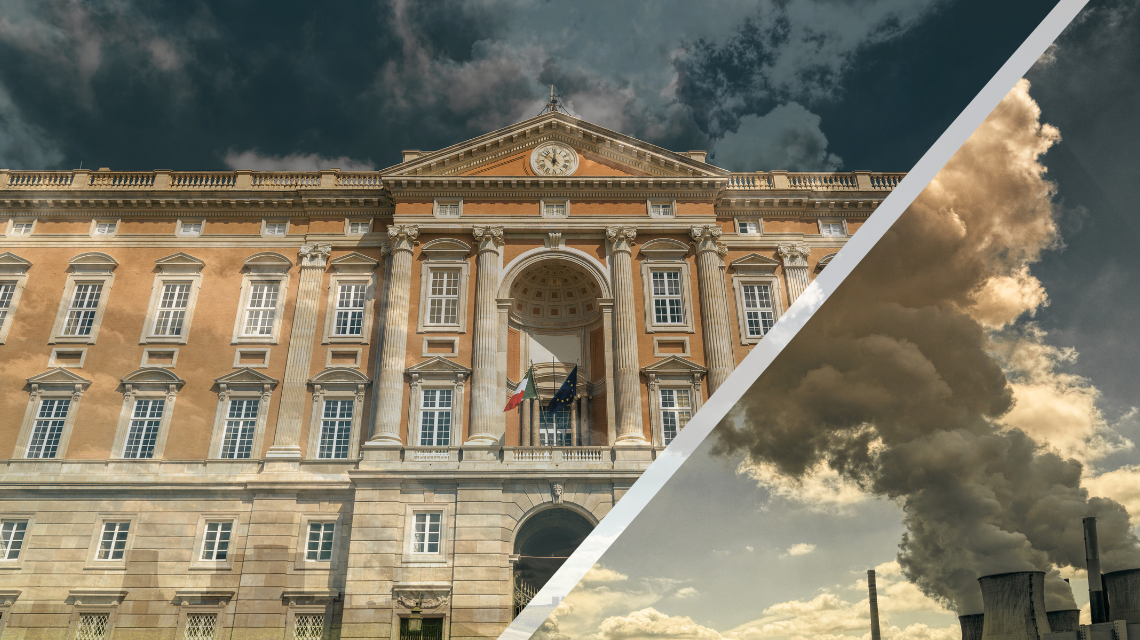Italian National Agency for New Technologies, Energy and Sustainable Economic Development

Cultural heritage: ENEA measures pollution impact on Royal Palace of Caserta
Pollution from cars, heating and industry is a key factor of deterioration of cultural heritage, as shown by an ENEA report which demonstrated the harmful effects of the main air pollutants (nitrogen oxides and PM10) on three UNESCO heritage sites: the Royal Palace of Caserta, the cathedral of San Doimo in Split (Croatia) and the Würzburg Residence (Germany).
“The Royal Palace of Caserta has been damaged the most. We have calculated a yearly surface corrosion rate higher than the target value set for 2050 (6.4 microns per year), which must not be exceeded if we want to preserve the state of health of the historic royal residence, visited by 700 thousand people every year", explained Teresa La Torretta at the ENEA Air Pollution Laboratory, co-author of the report with Pasquale Spezzano.
The air pollution measurement station positioned near the Royal Palace of Caserta showed high and stable nitrogen dioxide and fine PM10 particulate levels, remaining just above 20 micrograms per cubic meter. “The Royal Palace, located in the heart of the city, is therefore particularly exposed to air pollution from industry, heating and road transport, in addition to natural sources far from the city like marine aerosol and desert sand from the Sahara which cause an increase in PM10 particulate matter especially in southern Europe", said La Torretta.
A comparison of the state of health of the three UNESCO sites examined showed degradation speed values of the external surfaces below the 'safety threshold' for Würzburg and Split. An important factor determining the differences among the sites is local weather/climate condition (temperature, rainfall, relative humidity), which can exacerbate harmful effects of pollutants and, consequently, affect the rate of corrosion of stone surfaces.
In the study period considered (2015-2019) the three sample cities recorded a general decrease in emissions in all major sectors, except for nitrogen oxides (NOx) from maritime transport in Split (+16% in 2019 compared to 2015). In fact, in the same period a slight reduction in the pollutants of interest in the air (nitrogen dioxide and PM10) was found. However, it should be noted, for example, that nitrogen oxide emissions in Caserta (2779.26 tonnes in 2019, main sources of emissions are industry and road transport) are approximately three times higher than in Würzburg (868 .82 tons, main source road transport) and almost double compared to Split (1532.18 tons, main industry industry).
“A round-up of measures to reduce motor traffic congestion focused on public transport, car-sharing and low-emission vehicles should be adopted”, pointed out the ENEA researcher.
The degradation of cultural heritage materials due to air pollution is significantly less than 20-30 years ago, when acidification of rain and air pollutants like sulfur dioxide, contributed to a higher corrosion rate in urban areas. “Emissions of these pollutants have drastically declined, but have stabilised in recent years. Instead, concentrations of nitrogen dioxide (NO2) and PM10 particulate matter have not diminished to the same extent, contributing to deterioration of monuments and a rise in restoration and maintenance costs", said La Torretta.
The ENEA study is part of the "International Cooperative Program on Effects of Air Pollution on Materials, including Historic and Cultural Monuments (ICP Materials)" of the UNECE Convention on long-range transboundary air pollution (Air Convention). The UNECE Air Convention, adopted in 1979, provides a unique, binding regional instrument through which 51 parties in the pan-European Europe and North America cooperate to deliver emission reductions for the major pollutant substances.
In addition to causing deteriorations of monuments, air pollution is the largest environmental health risk in Europe, causing premature death and cardiovascular and respiratory diseases, according to a report by the European Environment Agency. Despite constant improvements, exceedances of air quality standards are common in Europe, with concentrations well above the latest WHO recommendations.
As regards air pollution, ENEA provides its "MINNI"[1] system, which draws 3-day hourly maps of the concentrations of pollutants, in particular fine particles, with a spatial resolution that in Italy reaches 4 km2, the size of a small municipality.
